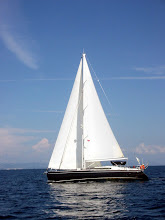And so we set off for Cabrera. The sky was clearing, there were even some blue patches around. Once away from the anchorage we decided that we would pull out the mainsail. There wasn't enough wind to sail by but the sail would add an extra half a knot or so to our speed and more importantly, it would steady the boat, keep her from rolling from side to side as she crossed the waves. We managed about an hour of motor sailing before bringing the sail in, there was no more wind. All around us storms were building up and we were sure that we would be soaked. Happily they all passed us by and we arrived in Puerto Cabrera warm and dry.
No sooner had we gone below decks than the storm hit. Perfect timing. And it was clean rain, water rain, no sand.
My eldest son tells me that I should describe in detail the bays that we anchor in and for some years I have been looking at bays, drawing a mental picture but in the end I have come to the conclusion that there is not much variety in what provides a safe anchorage, there are characteristics that are shared by all of them. However, here are my first impressions of Puerto Cabrera. The entrance is narrow and according to the pilot guide it is easy to enter in almost all sea conditions but my own feeling as we approached was that I wouldn't like to enter it in a storm. This was perhaps because of a strange occurrence when we were about two miles off. (I always mean nautical miles when I talk of sea passages, by the way: 1 nautical miles is just under 2kms.) Anyway, we were going along quite nicely. The rollers were larger now and I would estimate that there was a one meter sea running but it was not uncomfortable. Suddenly, Ganymede lurched violently to port, decks almost in the water, and then immediately to starboard, decks almost in the water again, before righting herself. At the same time, she dipped violently. Tony and I looked at each other, what was going on? Below decks, still not well packed, things were flying. That'll teach me. And then it was over. Thing was, there were things that were in their permanent positions and never moved in the fiercest of storms that jumped off shelves, over fiddles. Crazy! So I was nervous about going through that entrance.
There is a 14th century castle on the headland, keeping watch. This was once the lair of corsairs and the castle was built to keep them out. Once inside, the bay opens up, vaguely circular. Some 50 buoys have been laid. Depending on the season and availability, boats can stay one or two nights or even up to a week. There are a couple of little inlets. The safest, most comfortable, is over in the southwest corner and is reserved for the smallest boats. The main jetty is to the northeast of the bay where there are a few buildings, some housing the offices of the marine and nature reserve and of the military. There is also a small cantina serving drinks and icecreams and on good days, baguettes. There is another collection of buildings towards the south of the bay, possibly for military personnel. From the jetty a roadway leads along the bay, past the military base and a second jetty and on to a small beach. There is a steep track that leads behind the houses and up to the castle. It also goes down to the buildings that house the lighthouse personnel.
The land is mostly garrigue, hilly rather than mountainous. From our mooring in the middle of the cala we could see a track on the western side that we learned led to a lighthouse on the southwestern tip of the island, Punto Anciola. There are some trees in the middle of the island but mostly it is shrubs, rosemary, and low-growing plants. The other thing we can see from our anchorage is a solar farm.
The water is beautiful. To sit there in calm weather, enjoying the peace, watching the fish, must be very special. During our time there the water was always slightly agitated, waves rippling the surface, hiding the fish. But it was good. When an area is looked after like this, both on land and at sea, it is so easy to want to look after it too, to protect the environment, keep it pristine.
For weeks I had been looking forward to leaving the marina, to nights spent at anchor, the special silence, waking up in the middle of the night and hearing nothing... and then the gentle splash of a wave on the hull. Magic. So far this season it hadn't happened and the following night was no different with the constant slip slap of wave washing onto the hull. But I did discover that being on a mooring buoy was different, more steady. There was always wind, always some swell, but in my opinion the movement of the boat was gentler than if we had been at anchor. I liked buoys.

No comments:
Post a Comment